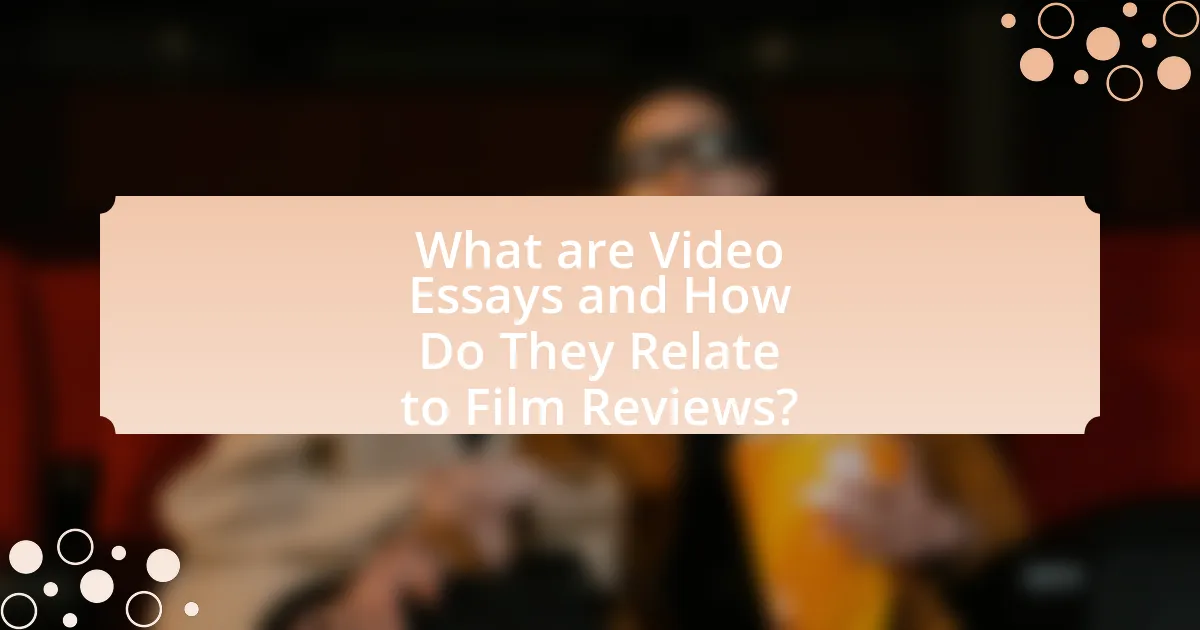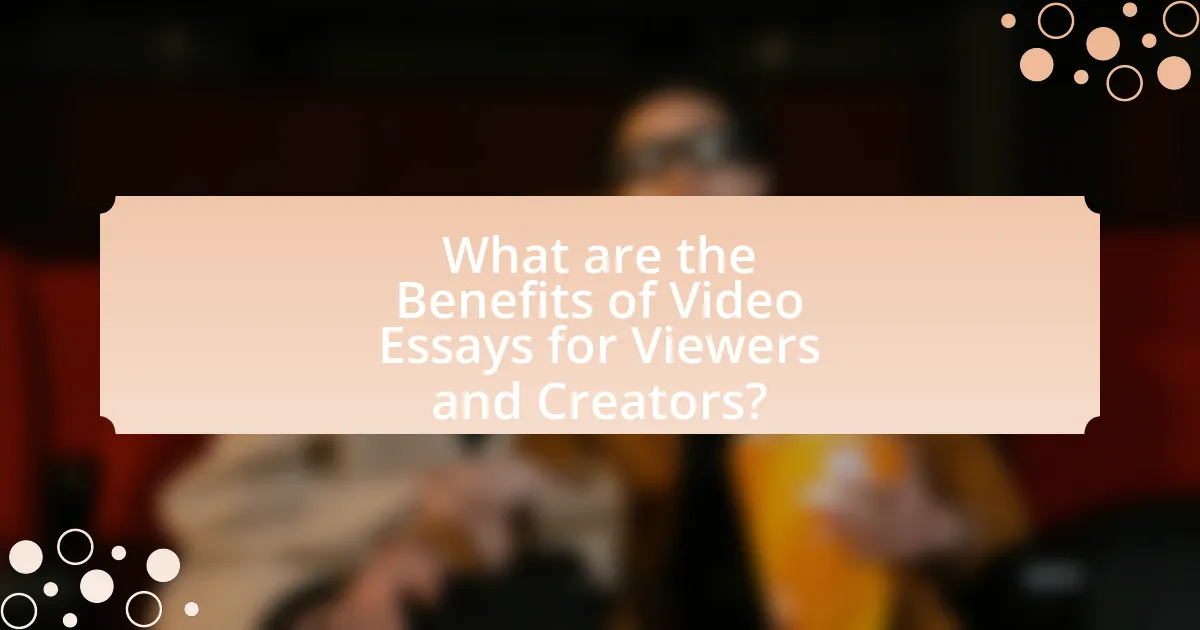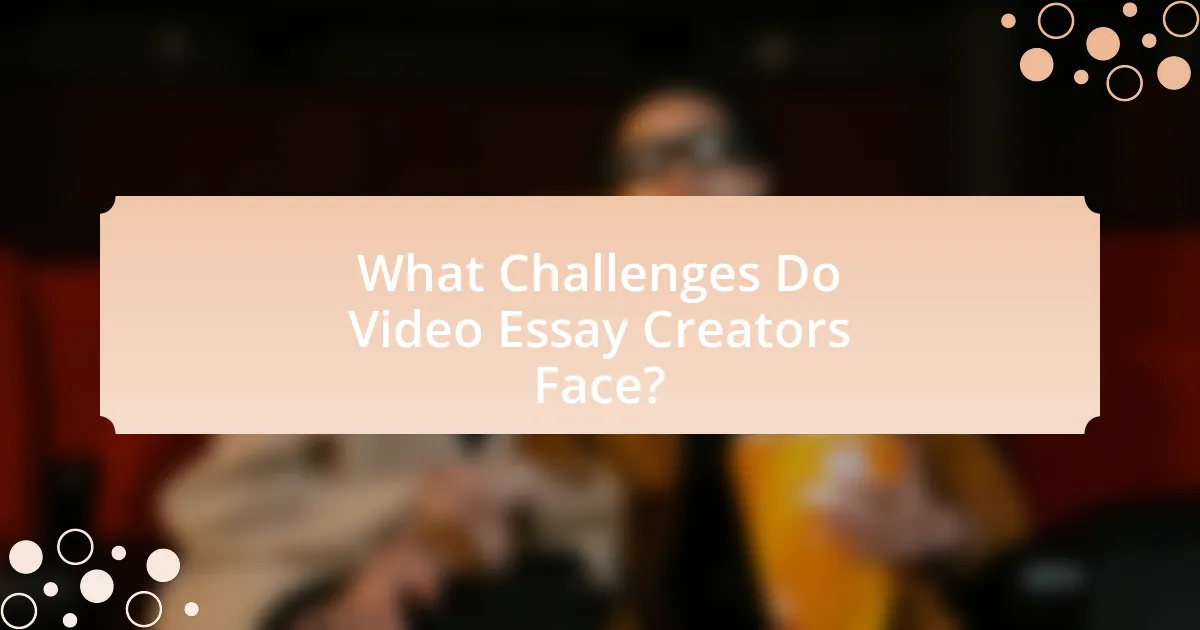Video essays represent a modern evolution in film critique, merging visual storytelling with analytical commentary to provide deeper insights into cinematic works. This article explores the emergence of video essays, tracing their roots to the early 2000s and the rise of digital platforms like YouTube, which democratized film analysis. Key figures in the development of this medium, such as Kevin B. Lee and Kogonada, are highlighted, along with the distinct narrative techniques and audiovisual elements that differentiate video essays from traditional film reviews. The article also addresses the benefits for both viewers and creators, the challenges faced in copyright and technical skills, and best practices for aspiring video essayists to build their unique voice and audience.

What are Video Essays and How Do They Relate to Film Reviews?
Video essays are a form of visual storytelling that combines video clips, narration, and analysis to explore themes, techniques, or critiques of films. They relate to film reviews by offering a more dynamic and engaging way to analyze and interpret movies, often providing deeper insights than traditional written reviews. Video essays utilize audiovisual elements to enhance the viewer’s understanding, making complex ideas more accessible. This format has gained popularity due to platforms like YouTube, where creators can reach wider audiences and present their analyses in a compelling manner, thus bridging the gap between academic critique and casual viewing.
How did Video Essays emerge as a form of film critique?
Video essays emerged as a form of film critique in the early 2000s, driven by the accessibility of digital editing tools and platforms like YouTube. These tools allowed filmmakers and critics to combine visual and auditory elements, creating a more engaging and nuanced analysis of films. The rise of video essays was further fueled by the growing popularity of online content consumption, enabling creators to reach wider audiences and share their insights on cinematic techniques, themes, and cultural contexts. Notably, video essays like “Every Frame a Painting,” created by Tony Zhou, exemplified this trend by blending film clips with commentary, showcasing the potential of this medium to enhance film critique.
What historical context led to the popularity of Video Essays?
The historical context that led to the popularity of video essays includes the rise of digital technology and the internet, which facilitated easier access to video production and distribution. In the early 2000s, platforms like YouTube emerged, allowing creators to share content widely and engage with audiences directly. This democratization of media production enabled individuals to analyze films in innovative ways, combining visual and auditory elements to enhance critical commentary. The increasing interest in film analysis, coupled with the growth of online communities and educational resources, further contributed to the acceptance and popularity of video essays as a legitimate form of film review.
Who are the key figures in the development of Video Essays?
Key figures in the development of video essays include Kevin B. Lee, who is recognized for pioneering the form with his work on video essays that analyze film and media. Another significant figure is Kogonada, known for his visually striking video essays that explore cinematic techniques and themes. Additionally, the contributions of filmmakers like Adam Westbrook and organizations such as the Criterion Collection have played a crucial role in popularizing video essays as a legitimate form of critique and analysis. These individuals and entities have collectively shaped the landscape of video essays, establishing them as an influential medium in film criticism.
What distinguishes Video Essays from traditional film reviews?
Video essays are distinguished from traditional film reviews primarily by their format and depth of analysis. While traditional film reviews typically provide a brief summary and opinion on a film’s quality, video essays often incorporate visual elements, such as clips and graphics, to explore themes, techniques, and cultural contexts in greater detail. This allows video essays to engage viewers on multiple levels, combining narrative storytelling with critical analysis. For instance, video essays often delve into specific cinematic techniques or societal implications, offering a more nuanced perspective than the standard review format, which usually focuses on entertainment value and personal opinion.
How do Video Essays utilize visual and auditory elements differently?
Video essays utilize visual and auditory elements in distinct ways to enhance storytelling and analysis. Visually, video essays employ imagery, graphics, and editing techniques to illustrate points, create emotional resonance, and engage viewers, often using clips from films or relevant visuals to support arguments. Auditory elements, on the other hand, include voiceovers, sound effects, and music, which serve to guide the viewer’s emotional response and provide context, often reinforcing the visual narrative. For example, a video essay analyzing a film’s themes may juxtapose poignant scenes with a reflective voiceover, creating a layered understanding of the material. This combination of visual and auditory elements allows video essays to convey complex ideas effectively, making them a powerful medium for film critique.
What narrative techniques are commonly used in Video Essays?
Video essays commonly utilize techniques such as voiceover narration, visual juxtaposition, and thematic analysis. Voiceover narration serves to guide the viewer through the argument or analysis presented, providing context and insight into the subject matter. Visual juxtaposition involves contrasting images or clips to highlight differences or similarities, enhancing the viewer’s understanding of the topic. Thematic analysis focuses on exploring underlying themes within the film or subject being discussed, often supported by relevant examples and clips. These techniques collectively enhance the narrative structure and engagement of video essays, making them an effective medium for film critique and analysis.

What are the Benefits of Video Essays for Viewers and Creators?
Video essays provide significant benefits for both viewers and creators by enhancing engagement and facilitating deeper understanding of content. For viewers, video essays combine visual and auditory elements, making complex ideas more accessible and enjoyable, which can lead to improved retention of information. Research indicates that multimedia learning can increase retention rates by up to 60% compared to traditional text-based formats. For creators, video essays offer a platform for creative expression and critical analysis, allowing them to showcase their unique perspectives while building a dedicated audience. This format also encourages interaction through comments and shares, fostering community engagement and feedback, which can enhance the creator’s visibility and influence in the film critique landscape.
How do Video Essays enhance viewer engagement with films?
Video essays enhance viewer engagement with films by providing in-depth analysis and visual storytelling that deepens understanding and appreciation of cinematic elements. This format allows creators to dissect themes, techniques, and narratives, making complex ideas accessible and stimulating discussion among viewers. Research indicates that video essays can increase retention of information and emotional connection to the material, as they combine visual and auditory stimuli, which are more effective for learning than text alone. For example, a study published in the Journal of Visual Literacy found that multimedia presentations, like video essays, significantly improve viewer engagement and comprehension compared to traditional reviews.
What role does storytelling play in viewer connection?
Storytelling plays a crucial role in viewer connection by creating emotional engagement and relatability. When narratives are well-crafted, they resonate with viewers’ experiences and feelings, fostering a sense of empathy and understanding. Research indicates that stories activate the brain’s mirror neurons, which enhance emotional responses and connection to characters and situations. This phenomenon is supported by studies showing that viewers are more likely to remember and relate to content that incorporates storytelling elements, as it transforms abstract concepts into relatable experiences.
How do Video Essays foster a community of film enthusiasts?
Video essays foster a community of film enthusiasts by providing an accessible platform for in-depth analysis and discussion of films. These visual narratives encourage viewers to engage with cinematic content critically, often highlighting themes, techniques, and cultural contexts that resonate with audiences. The interactive nature of video essays, often hosted on platforms like YouTube, allows for immediate feedback and dialogue among viewers, creating a shared space for exchanging ideas and interpretations. This communal engagement is evidenced by the high volume of comments and discussions that accompany popular video essays, demonstrating a collective investment in film analysis and appreciation.
What advantages do creators gain from producing Video Essays?
Creators gain several advantages from producing video essays, including enhanced audience engagement, the ability to convey complex ideas visually, and opportunities for monetization. Video essays allow creators to connect with viewers on a deeper level through storytelling and visual elements, which can lead to increased viewer retention and interaction. Additionally, the format enables creators to break down intricate subjects, making them more accessible and understandable. Monetization opportunities arise through platforms like YouTube, where creators can earn revenue from ads, sponsorships, and viewer donations, as evidenced by the growing number of channels dedicated to this format that have successfully generated income.
How can Video Essays serve as a platform for creative expression?
Video essays serve as a platform for creative expression by allowing creators to blend visual storytelling with personal commentary. This format enables individuals to articulate their unique perspectives on film, art, or culture through a combination of images, sound, and narrative. The integration of various multimedia elements fosters innovation and encourages experimentation, as creators can manipulate visuals and audio to enhance their message. Research indicates that video essays have gained popularity due to their ability to engage audiences in a more dynamic way compared to traditional written reviews, as they can evoke emotional responses and provoke thought through visual rhetoric.
What opportunities do Video Essays provide for monetization?
Video essays provide several monetization opportunities, including ad revenue, sponsorships, and crowdfunding. Creators can earn ad revenue through platforms like YouTube, where monetization is enabled once they meet specific criteria, such as 1,000 subscribers and 4,000 watch hours in the past year. Additionally, video essayists can collaborate with brands for sponsored content, leveraging their audience to promote products or services. Crowdfunding through platforms like Patreon allows creators to receive direct financial support from their viewers, often in exchange for exclusive content or perks. These methods have been successfully utilized by numerous video essayists, demonstrating the viability of monetization in this format.

What Challenges Do Video Essay Creators Face?
Video essay creators face several challenges, including copyright issues, audience engagement, and technical skills. Copyright issues arise because creators often use clips from films or other media, which can lead to content being flagged or removed due to infringement. Audience engagement is crucial, as creators must find ways to attract and retain viewers in a saturated market, often competing with traditional film reviews and other content formats. Additionally, technical skills are necessary for video editing and production, which can be a barrier for those without prior experience or resources. These challenges highlight the complexities of producing video essays in a competitive and regulated environment.
How do copyright issues impact the creation of Video Essays?
Copyright issues significantly impact the creation of video essays by limiting the use of copyrighted materials, which can hinder the ability of creators to incorporate essential clips, images, and music. Video essayists often rely on these elements to provide context, critique, or commentary, but copyright law requires them to seek permission or risk legal repercussions. The fair use doctrine may allow some leeway for educational or transformative purposes, yet its application is often ambiguous and varies by jurisdiction, leading to uncertainty for creators. For instance, a study by the Stanford University Libraries highlights that many video essayists self-censor their work due to fear of copyright infringement, which can stifle creativity and limit the diversity of perspectives presented in this medium.
What strategies can creators use to navigate copyright laws?
Creators can navigate copyright laws by utilizing fair use provisions, obtaining licenses for copyrighted material, and creating original content. Fair use allows limited use of copyrighted material without permission for purposes such as criticism, commentary, or education, which is particularly relevant for video essays that analyze films. Additionally, creators can seek licenses from copyright holders to use specific clips or music legally. By focusing on original content creation, such as personal insights or unique interpretations, creators can minimize the risk of copyright infringement. These strategies are supported by legal frameworks that recognize the balance between protecting creators’ rights and promoting creativity and expression.
How does fair use apply to Video Essays?
Fair use applies to video essays by allowing creators to use copyrighted material without permission under certain conditions. Video essays often incorporate clips, images, or music from existing works to provide commentary, criticism, or educational insights, which are key factors in determining fair use. The four factors considered in fair use analysis include the purpose and character of the use (transformative nature), the nature of the copyrighted work, the amount and substantiality of the portion used, and the effect of the use on the market for the original work. For instance, a video essay that critiques a film by analyzing specific scenes may qualify as fair use if it adds new meaning or context, thereby transforming the original content. Courts have upheld this principle in cases involving educational and critical content, reinforcing that video essays can legally utilize copyrighted materials when they meet these criteria.
What technical skills are necessary for producing effective Video Essays?
Producing effective video essays requires technical skills in video editing, sound design, and scriptwriting. Video editing skills are essential for assembling footage, applying transitions, and ensuring a coherent narrative flow. Proficiency in software such as Adobe Premiere Pro or Final Cut Pro is often necessary, as these tools allow for precise editing and visual effects. Sound design skills are crucial for enhancing audio quality, incorporating background music, and ensuring clear voiceovers, which can significantly impact viewer engagement. Additionally, strong scriptwriting abilities are important for crafting compelling narratives that effectively convey the intended message, as a well-structured script serves as the backbone of the video essay. These skills collectively contribute to the overall quality and effectiveness of the final product.
What software and tools are commonly used in Video Essay production?
Commonly used software and tools in video essay production include Adobe Premiere Pro, Final Cut Pro, and DaVinci Resolve for video editing. These programs are favored for their robust editing capabilities and user-friendly interfaces. Additionally, tools like Adobe After Effects are utilized for motion graphics and visual effects, enhancing the overall presentation of video essays. Audio editing software such as Audacity or Adobe Audition is often employed to ensure high-quality sound. The combination of these tools allows creators to produce engaging and polished video essays that effectively communicate their analyses and insights.
How can creators improve their editing and storytelling skills?
Creators can improve their editing and storytelling skills by actively studying narrative structures and practicing editing techniques. Engaging with various storytelling frameworks, such as the three-act structure or the hero’s journey, allows creators to understand how to build compelling narratives. Additionally, utilizing editing software effectively, such as Adobe Premiere Pro or Final Cut Pro, enhances technical skills, enabling smoother transitions and pacing. Research indicates that creators who analyze successful video essays, like those by Lindsay Ellis or ContraPoints, can identify effective storytelling methods and editing styles, which can be replicated in their own work.
What are the best practices for aspiring Video Essay creators?
Aspiring video essay creators should focus on thorough research, clear storytelling, and high-quality production. Conducting in-depth research ensures that the content is informative and credible, which is essential for engaging the audience. Clear storytelling involves structuring the essay with a strong introduction, coherent arguments, and a compelling conclusion, allowing viewers to follow the narrative easily. High-quality production, including good audio and visual elements, enhances viewer experience and retention. According to a study by the Pew Research Center, well-produced video content significantly increases viewer engagement, highlighting the importance of production quality in retaining audience attention.
How can one develop a unique voice in Video Essay creation?
To develop a unique voice in video essay creation, one should focus on personal storytelling and distinctive stylistic choices. Personal storytelling involves integrating individual experiences and perspectives, which can resonate with viewers and differentiate the content. Distinctive stylistic choices include unique editing techniques, visual aesthetics, and narrative structures that reflect the creator’s personality. For instance, video essays by creators like Lindsay Ellis and ContraPoints showcase their unique voices through specific thematic focuses and engaging presentation styles, which have garnered significant audiences. This approach not only enhances viewer engagement but also establishes a recognizable brand within the video essay community.
What tips can help in building an audience for Video Essays?
To build an audience for video essays, creators should focus on producing high-quality, engaging content that resonates with viewers. Consistency in uploading videos, optimizing titles and descriptions for search engines, and promoting content on social media platforms can significantly enhance visibility. Research indicates that video essays that incorporate storytelling elements and visual aesthetics attract more viewers, as they create a compelling narrative that keeps audiences engaged. Additionally, collaborating with other creators can expand reach and introduce content to new audiences, further solidifying a channel’s presence in the video essay community.